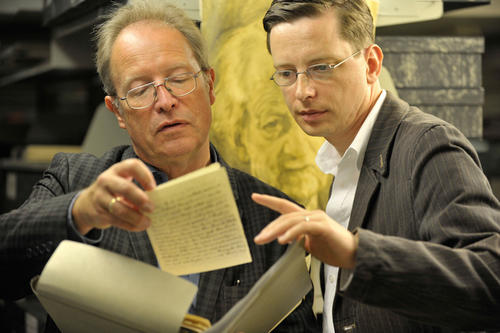Like Unearthing Buried Treasure
Countless boxes with 81,000 letters: Literature scholars at Freie Universität Berlin digitize letters left by Gerhart Hauptmann
Oct 26, 2011
Hand-written treasures: A team of researchers led by Tim Lörke (r.) and Peter Sprengel (l.) explore the letters left by Gerhart Hauptmann.
Hauptmann eventually discarded the idea of suicide – he did not die until 50 years later, at the age of 83 – but he remained a dedicated correspondent. In his role as part of the cultural and intellectual elite, Hauptmann exchanged letters with unsurpassed diligence. From Bebel to Goebbels, from Mahler to Strauss, from Rathenau to Liebermann: The leading intellectual figures of the time shared their ideas with the playwright, planned projects together, and tried to win him over for their goals.
“In his day, Gerhart Hauptmann was one of the most influential figures in Germany,” says Peter Sprengel, a professor of modern German literature at Freie Universität Berlin. Sprengel has been studying Hauptmann’s life and works for many years now. In March of this year, the German Research Foundation (DFG) began supporting a project to explore the letters left behind by Hauptmann using electronic tools.
Sprengel and project manager Tim Lörke, who holds a doctorate in literature from Freie Universität, are working together with the Staatsbibliothek zu Berlin (Berlin State Library), which has held Hauptmann’s estate since the late 1960s. “Hauptmann’s letters are one of the largest estates ever in the history of German literature,” Sprengel says with enthusiasm, continuing that the materials they contain are like “buried treasure.”
The comparison with a treasure hunt certainly seems appropriate: All told, the estate includes 81,000 letters. Sprengel and Lörke are focusing first on the 6,000 of them written by Hauptmann himself. Their content is exciting in itself, and even the way the researchers physically reach the documents sounds like an adventure: “The catacombs of the State Library are a gigantic complex, with tunnels that run on forever,” says Lörke.
“Hauptmann as a figure has faded into the background today, which is probably due in part to the author’s ambivalent role during the Third Reich,” Sprengel says. While there is no evidence to support the assertion that Hauptmann wished to join the Nazi Party in 1933, and still less reason to believe that he identified with National Socialism as such, his voice was conspicuously absent in expressing criticism of the regime, and he did remain in Germany.
The scanned letters are being made available online in the Kalliope database, the central German catalog for estates and autographs, which contains information on the writer, intended recipient, and place and date of origin. Like with a search engine, users can also use keywords and names of people to find letters containing those terms. In addition to this indexing process, Sprengel and Lörke are also preparing annotated compilations that summarize the content of Hauptmann’s letters according to objective criteria.
The exploration of the author’s letters extends beyond the items found in the State Library: Alongside the 81,000 letters in the library’s collections, there are also other letters in libraries and archives in Germany and abroad, as well as in private collections. Due to this fact, Sprengel and Lörke hope that it will be possible to extend the project, which is initially set to run for two years. Up until then, there is still time to unearth surprising treasures from the depths of the Hauptmann boxes.
“I, for instance, would never have expected to find that Hauptmann was considering writing an opera with Richard Strauss,” Lörke says. “The letters show how closely the representatives of different cultural disciplines and viewpoints worked together and how much they influenced each other during that time period.” Lörke continues that reading the letters prompts researchers to view not only the recording and shaping of the cultural history of the Weimar Republic, but also Hauptmann’s own role during the two World Wars, through new eyes. “During World War I, he was on the side of the war policy,” says Sprengel, “but during the Third Reich, he was torn between national identity and the suffering of the victims.”
Goebbels’s diaries, Sprengel says, show the propaganda minister’s dislike of the playwright, but Goebbels nonetheless made repeated attempts to win Hauptmann over for propaganda purposes. The author’s own letters to close friends are the most immediate source of information on his actual position during this time.
Further Information
- Prof. Dr. Peter Sprengel, Freie Universität Berlin, Institute of German and Dutch Languages and Literatures, Modern German Literature, Tel.: +49 (0)30 / 838-521 99, Email: sprengel@zedat.fu-berlin.de
- Dr. Tim Lörke, Freie Universität Berlin, Institute of German and Dutch Languages and Literatures, Modern German Literature, Tel.: +49 (0)30 / 838-55415, Email: tim.loerke@fu-berlin.de

